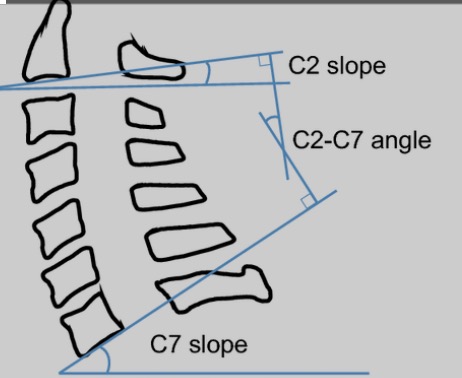C2 slope
see also C2 tilt, T1 slope, C7 slope.
C2 slope is defined as the angle between a horizontal reference and a line parallel to the inferior end plate of C2 as measured on a lateral radiograph or cephalometric X-ray.
This measurement is used to evaluate the sagittal alignment of the upper cervical spine and assesses the relationship between the skull and the cervical spine. A steep C2 slope angle indicates a more forward position of the upper cervical spine relative to the skull, while a shallow C2 slope angle indicates a more backward position.
The normal range of the C2 slope angle can vary depending on factors such as age, gender, and ethnicity. Generally, a C2 slope angle within 10 to 30 degrees is considered normal for adults, with a slightly larger range of 0 to 40 degrees in children and adolescents.
However, it's important to note that there is no single “pathologic” value for the C2 slope angle that definitively indicates the presence of a spinal disorder or disease. In some cases, a C2 slope angle outside of the normal range may be associated with conditions such as cervical spondylotic myelopathy, cervical instability, or cervical deformity, but the clinical significance of this finding depends on the individual patient and their specific circumstances.
In clinical practice, the interpretation of the C2 slope angle must take into account a range of other factors, including patient symptoms, radiographic findings, and medical history, in order to arrive at an accurate diagnosis and appropriate treatment plan.
C2 slope correlated with upper-cervical and subaxial alignment. C2S correlated strongly with the T1 slope minus cervical lordosis (TS-CL) (R = 0.98, P < 0.001) because C2S is a mathematical approximation of TS-CL. C2S is a useful marker of cervical deformity, linking the occipitocervical and cervicothoracic spine. C2S defines the presence of a mismatch between cervical lordosis and thoracolumbar alignment. Worse 1-year postoperative C2 slope correlated with worse health outcomes 1).
Results indicate that the correction of the C2 slope should be prioritized during cervical deformity surgery, with the selection of a stable lowest-instrumented vertebra (LIV) and correction of the cervical sagittal vertical axis below the idealized threshold. Among the numerous radiographic parameters considered during preoperative planning for cervical deformity correction, determinations help surgeons prioritize those realignment strategies that maximize health-related quality-of-life outcomes and minimize complications 2)
